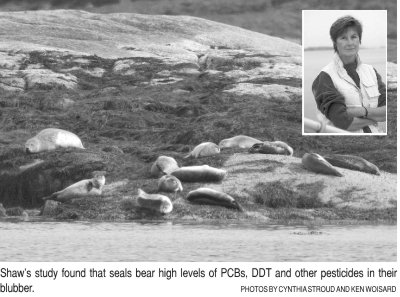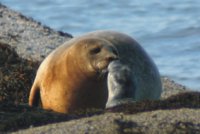
Seals carry heavy pollution burden
Printer Friendly Page
By Maureen Kelly
Conducted by Dr. Susan Shaw, founder and executive director of the Marine Environmental Research
Institute in Blue Hill, Maine, the studies tested 60 stranded and captured seals. The research
provides the first
extensive look at levels of persistent organic pollutants (POPs) and other contaminants in the
region's harbor seals since the 1970s.
POPs are man-made chemicals such as dioxins, furans, dioxin-like PCBs and pesticides such as
DDT that are slow to degrade and can linger in the environment for decades. Animals that feed at
the top of the food chain accumulate POPs in their fatty tissues from eating contaminated fish or
other organisms. Mothers pass the toxins on to their young in the womb and through nursing.
Since 2001, Shaw, an environmental toxicologist and public health professional, has been
gathering data on what she calls "the cocktail of pollutants that are in all wildlife and humans" to
see if there is an association between the levels of toxins in seal blubber and health.
The harbor seals that live along the coast from Maine to New Jersey have multiplied over the past
two decades to a seemingly robust population of about 100,000 animals. But Shaw cautions, "Just
looking at numbers doesn't tell you much about health."
Several mass die-offs in the region over that same period suggest that the seal population in
the region may be susceptible to recurrent viral disease outbreaks, according to Shaw.
In 1979 and 1980, influenza spread from Cape Cod through the Gulf of Maine killing 500 harbor
seals. Phocine distemper virus (PDV), a pathogen related to canine distemper virus, infected harbor
seals from southern Maine to New York in 1991 and 1992.
Most recently, during the summer of 2004, about 300 harbor seals - mostly pups - turned up dead
on the coast of southern Maine over the course of several weeks. The cause is still undetermined.
In trying to understand the cause of mass seal mortalities in other parts of the world, many
scientists have considered exposure to POPs a factor that may predispose seals to disease by
weakening their immune systems. Some POPs, notably the polychlorinated biphenyls (PCBs), are
"endocrine disruptors" that interfere with the hormones that trigger the growth of an organism and
can cause immune system dysfunction, developmental problems and sexual and reproductive
abnormalities. PCBs and dioxins are also cancer-causing chemicals in animals and humans.
After PDV decimated the seal population in northwestern Europe in 1988 leaving over 20,000
dead, a Dutch study investigated the role contaminants might have played. The researchers found
that seals fed a diet of herring from the notoriously polluted Baltic Sea had higher levels of
POPs than seals fed on Atlantic herring. The Baltic seals also showed signs of immune deficiencies.
PCBs were the most prevalent contaminant Shaw found in the blubber of the stranded seals she
studied. Adult males had the highest levels followed by pups, yearlings, adult females and fetuses.
The higher amounts in adult males, as opposed to females, could be attributed to the females
transferring some of their toxic burden to their pups when nursing.
Compared to other industrial areas of the world, U.S. Atlantic coast seals have PCB burdens in
"the high-middle range of the contaminant spectrum," Shaw said. Seals from the Baltic, Dutch Wadden
and Caspian Seas have the highest PCB loads in the world.
Other pollutants are also of concern. Mercury levels, obtained from hair and liver samples,
suggest that the metal may be increasing in the region's harbor seals. Levels in liver samples of
adult seals from Maine exceeded threshold levels for liver damage in mammals. Young seals exposed
to mercury in the womb or from their mothers' milk may be particularly vulnerable, as are young
humans, to neurological effects.
Shaw will be expanding her research to study more free-living seals and to look at other
chemicals that are accumulating in marine mammals. She will be investigating flame retardant compounds, PBDEs
(polybrominated diphenyl ethers) that are widely used in electrical appliances, upholstery,
and foams. PBDEs which are banned in Europe, are rapidly building up in the environment. “Concerns
about PBDEs have arisen because of their increasing presence in human tissues in Europe, Canada
and the United States, and their association with endocrine disruption and reproductive and
developmental toxicity including neurotoxicity in young mammals,” Shaw said.
 AFTER FOUR YEARS of study on U.S Atlantic coast seals, a Maine researcher and her colleagues have
found that seals in the region bear high levels of PCBs, DDT and other pesticides in their blubber,
and that substances banned in the United States as long ago as the 1970s are still cycling in the
environment.
AFTER FOUR YEARS of study on U.S Atlantic coast seals, a Maine researcher and her colleagues have
found that seals in the region bear high levels of PCBs, DDT and other pesticides in their blubber,
and that substances banned in the United States as long ago as the 1970s are still cycling in the
environment.
 It is unclear whether pollutants played a role in the die-offs along the U.S. Atlantic coast,
but Shaw's research shows that the burden of PCBs and pesticides carried by some seals is enough
to impair immune function and effect reproduction and endocrine function.
It is unclear whether pollutants played a role in the die-offs along the U.S. Atlantic coast,
but Shaw's research shows that the burden of PCBs and pesticides carried by some seals is enough
to impair immune function and effect reproduction and endocrine function.